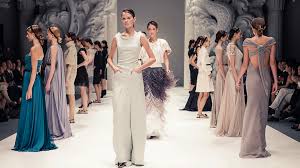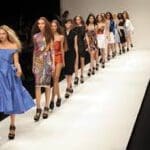 Fashion Show
Fashion Show
A fashion show is an event put on by a fashion designer to showcase their upcoming line of clothing and/or accessories during Fashion Week. Fashion shows debut every season, particularly the Spring/Summer and Fall/Winter seasons. This is where the latest fashion trends are made.
Fashion week
A fashion week is one of the most anticipated events in the fashion industry. Many works are out into the preparation of wears and other fashion items. Individuals spend thousands to shop for clothes, shoes, jewelry, etc., in preparation for the fashion week. Both upcoming and top designers and brands will display their upcoming collections in various events that will be organized during the fashion week. The most popular fashion weeks are held in New York, Milan, Paris, and London.
Fashion week is usually twice in a year event. The timing target the period when seasons change to introduce new fashion trends for the upcoming season. The February and March fashion weeks are focused on showcasing fashion trends for autumn and winter. At the same time, September and October fashion weeks are dedicated to spring and summer collections.
Types of fashion show
Fashion show comes in various forms and sizes. You can attend a fashion show with so many audiences and display other art categories. Other fashion shows can focus only on clothes, shoes, jewelry, bags, and specs. The event varies and can be as diverse as fashion itself. Some fashion events are created to showcase the latest trends in a particular style, such as gowns, coats, etc. When you get to such shows, you will only see a different display of a particular type of wear. Here are the main six types of fashion shows:
- A formal runway fashion show
- A production fashion show
- An informal fashion show
- Designer fashion show
- Charity fashion show
Sponsored fashion show
1.A formal runway show-
From the name, a runway fashion show is that where models parade a platform to display or showcase different designer’s products. Many people are familiar with this type of fashion show as it’s being employed everywhere. The model wears the clothes or any other product to be showcased to let people know how the item will be when wore and how easy it is to walk in the item.
A runway fashion show does not usually take much time and can quickly give buyers time to discuss with designers and make purchases. Although a runway show can be done in various ways, most runway shows have a unique style. Some runway events have specific hairstyles for female models, a special style of makeup, etc. Some runway shows are strictly formal, while some permit a range of flexibility.
2.A production show-
A lot of work and effort going into this type of fashion show is probably the most expensive of all the fashion shows. A theatrical performance is used to showcase fashion trends in a production fashion show.
Special effects, lighting effects, live performances such as dancing and acting are used to display the fashion items, which is why it’s more expensive than other types of fashion shows. About 5 to 50 models can be used in a production show. The similarity between a production fashion show and a runway fashion show is that the fashion items are displayed on models, making onlookers know how they will fit and look with body movement.
3.An informal fashion show-
An informal fashion show occurs when the fashion items are showcased in a rather informal environment. In some of this event, models put on the items and stand or mingle around; such an event can happen in a department store or other places.
There is not much preparation needed to put up such events. The only preparation I usually the process of getting the model ready in terms of makeup and hairstyles. After this, the model puts on the cloth and starts mingling around. In such events, much crowd is not present, and it’s a little subliminal.
4.Designer fashion show-
In a designer fashion show, a designer can be chosen to showcase their fashion collection for about 30 minutes, after which another designer is given a chance. A single brand can organize such shows and display their items by categories.
5.Charity fashion show-
As the name goes, a charity fashion show is organized for charitable purposes and helps with a humanitarian crisis. In such shows, brands can sell their products and vow to give a certain percentage of their sale to charity purposes.
6.Sponsored fashion show-
A sponsor organizes such events, or an organization and designers are invited to showcase their fashion collections. The sponsor can dedicate the event to some purposes or towards a particular goal.
Important organizing tips of fashion shows are:
- Date and venue
- License
- The catwalk
- Model
- Fashion runway
- Themes
- Hairdressers and makeup
- The clothes
- Rehearsal
- Advertising
- The team (For price and management)
- Producer
- Backstage manager
- Entertainment manager
Indian Fashion Show
India Fashion Week is a bi-annual fashion week organized and promoted by the Fashion Design Council of India. It was sponsored by Wills Lifestyle from 2006–2014 before Amazon.in became the sponsor. The first event in 2000 featured the work of 33 designers.

Modelling
A model is a person with a role either to promote, display or advertise commercial products (notably fashion clothing in fashion shows) or to serve as a visual aid for people who are creating works of art or to pose for photography. Though models are predominantly female, there are also male models, especially to model clothing. Models may work professionally or casually.

(“modeling” in American English) is considered to be different from other types of public performance, such as acting or dancing. Although the difference between modelling and performing is not always clear, appearing in a film or a play is not generally considered to be “modelling”. Similarly, appearing in a TV advertisement is generally not considered modelling. Modelling generally does not involve speaking. Personal opinions are generally not expressed and a model’s reputation and image are considered critical.Types of modelling include: fashion, glamour, fitness, bikini, fine art, body-part, promotional and commercial print models. Models are featured in a variety of media formats including: books, magazines, films, newspapers, internet and television. Fashion modelling as a profession is sometimes featured in films (Prêt-à-Porter and Looker), reality TV shows (America’s Next Top Model and The Janice Dickinson Modeling Agency) and music videos (“Freedom! ’90“, “Wicked Game“, “Daughters” and “Blurred Lines“).
Celebrities, including actors, singers, sports personalities and reality TV stars, frequently participate in modelling contests, assignments as well as contracts in addition to their regular work. Often, modelling is not a full-time, main activity.
Design
A design is a plan or specification for the construction of an object or system or for the implementation of an activity or process, or the result of that plan or specification in the form of a prototype, product or process. The verb to design expresses the process of developing a design.
Costume
Costume is the distinctive style of dress of an individual or group that reflects class, gender, profession, ethnicity, nationality, activity or epoch.
The term also was traditionally used to describe typical appropriate clothing for certain activities, such as riding costume, swimming costume, dance costume, and evening costume. Appropriate and acceptable costume is subject to changes in fashion and local cultural norms.[1]
“But sable is worn more in carriages, lined with real lace over ivory satin, and worn over some smart costume suitable for an afternoon reception.” A Woman’s Letter from London (23 November 1899).[2]
This general usage has gradually been replaced by the terms “dress”, “attire”, “robes” or “wear” and usage of “costume” has become more limited to unusual or out-of-date clothing and to attire intended to evoke a change in identity, such as theatrical, Halloween, and mascot costumes.
Before the advent of ready-to-wear apparel, clothing was made by hand. When made for commercial sale it was made, as late as the beginning of the 20th century, by “costumiers”, often women who ran businesses that met the demand for complicated or intimate female costume, including millinery and corsetry.

Conclusion
Fashion shows are organized to keep people updated about fashion trends or the upcoming collections of some fashion brands. The fashion industry is ever-evolving, and the best way to keep yourself up-to-date about the latest trends is through fashion shows. And as mentioned above, fashion shows serve various purposes, and some are dedicated to certain wears. Attending fashion shows that permits a diversity of styles is more beneficial as you will learn more from those than others.
Some of those shows are strictly by invitation, and others might have free entry. However, you can follow most of those shows online on their respective channels, and you won’t miss out on much.Guide-Nicolas Desjardins


 Fashion Show
Fashion Show


